中考英语语法专题详解三
初中英语中考 语法图解过关 专题三 冠词

约800年前,土耳其南部的一个人发明了一种神奇的钟。
前往
考情
图解
重难
随堂
前,特指某(些)人或 teacher. 穿红衣服的女士是我们的英语
某(些)物
老师。
特指
Once upon a time there was an
用于特指上文提及
emperor. The emperor liked beautiful
的或谈话双方都知
clothes very much. 从前有一个国王。
相当于each或per
举行五次。
前往
考情
图解
重难
随堂
重难 重难点1 不定冠词a/an的用法
提分技法
用法
示例
用在what, such, half,such a hot day 如此热的一天
quite等词之后
half an hour 半小时
其他
与可数名词单数连用,表 There’s a tree in front of my
(7)用在某些形容词前,表某一类人或物 He often helps the poor.
(8)用于由普通名词构成的专有名词前 The Great Wall is very famous.
(9)用于一些固定短语中 Thank you all the same.
前往
考情
图解
重难
随堂
重难 重难点1 不定冠词a/an的用法
现在完成时中考高频考点总结(讲义)2024年英语中考三轮复习语法专题

2024年初三英语中考三轮复习【语法专题】现在完成时中考高频考点总结(讲义)用法a:表示过去某时刻发生的动作对现在造成的影响或结果:常与already, yet, just, ever, never... before, this morning, now, today, so far, in the last/past+时间段, over+时间段, recently, by+现在时间等连用;b: 从过去某一时刻开始,一直延续到现在的动作或状态:后者常与for引导的一段时间或since引导的时间点或过去时间状语从句连用。
Jack has just turned off the light. 杰克刚刚把灯关上。
(结果:现在灯灭着)I have lost my pen. 我把钢笔丢了。
(结果:我现在没有钢笔用。
)James is on holiday. He has gone to Italy. (= He is there now or on his way there)吉姆斯在度假。
他去意大利了。
(人可能已经到了或者在路上)Amy is back home now. She has been to Italy. (=she has now e back.)艾米现在回家了。
她去过意大利。
(人已经回来了)现在完成时的常见标志语(1)already已经already通常用于肯定句中,可放在助动词之后,过去分词之前,也可放在句末。
I've already read this book.我已经读过这本书了。
I've washed my clothes already.我已经洗了衣服。
注意在表示吃惊或明知故问等感情色彩时,already也可用于疑问句中。
如Have you met him already? 你(真的)已经见过他了?(2)yet已经;还yet用在疑问句中,意为“已经”,用在否定句中意为“还”,常放在句末。
专题03-冠词-备战2023年中考英语一轮复习语法专项练(通用版)(解析版)

专题03-冠词备战2023年中考英语一轮复习语法专项练(通用版)一、单项选择1.It’s a nice day today! Let’s go for ________ walk.A.a B.an C.the D./【答案】A【详解】句意:今天天气真好!我们去散步吧。
考查冠词辨析。
go for a walk“去散步”,固定搭配,故选A。
2.My uncle has ________ good habit of swimming every day.A.an B.the C.a D./【答案】C【详解】句意:我的叔叔有每天游泳的好习惯。
考查冠词的用法。
此处泛指一个习惯,good 首字母发辅音音素,故选C。
3.We are going to have ________ big exam at ________ end of the term.A.an; the B.a; the C.an; /D.a; an【答案】B【详解】句意:我们将在学期末举行一次大考。
考查冠词。
a不定冠词,修饰辅音音素开头的单词;an不定冠词,修饰元音音素开头的单词;the定冠词,表示特指;第一空泛指“一次大考”,应用不定冠词,big是辅音音素开头的单词,应用a修饰;at the end of...“在……结束时”,是固定短语,故选B。
4.—You’ve dropped ________ “f” in the word “giraffe”.—Oh, ________ letter “f” should be doubled.A.a; a B.a; the C.an; the D.an; a【答案】C【详解】句意:——你在“giraffe”这个词里少了一个“f”。
——哦,应该双写字母“f”。
考查冠词辨析。
a用于辅音音素前;an用于元音音素前;the表示特指。
根据“f”可知,字母发音是元音音素开头,an符合句意;再者根据“letter”可知,此处表示特指已经提到的字母,the符合句意;故选C。
初中英语语法知识—祈使句的真题汇编及答案解析(3)

一、选择题1.Tom, laugh at(嘲笑)others. It’s not polite!A.don't B.doesn’t C.not D.don't be 2.—When and where shall we meet tomorrow?—Let’s _______ it 3:00 p. m. at my home.A.do B.make C.meet D.plan3.Mike, __________ make any noise, your father is sleeping.A.not B.don't C.won't D.can't4.Do you want to be healthy? ___. Smiling can help you stay healthy.A.Smiles B.Smiling C.To smile D.Smile5.Tim,______noisy in the library.A.don’t B.doesn’t C.don’t be D.doesn’t be6.Get up early, _____ you’ll be late for class.A.so B.or C.and D.but7.Be quick, ______ you will be late for the school art festival .A.and B.or C.but D.so8.Let’s ______ sports after school. Sports are good for health.A.have B.having C.to have D.has9.Tina, _____________the room by yourself.A.cleans B.will clean C.cleaned D.clean10.—______________.—G-R-E-E-N, green.A.What's this? B.What color is it? C.Spell it, please. 11.Take more exercise, you will be healthier.A.but B.or C.and12.Walk ______ the white building and ______ the street. You won’t miss it.A.pass; cross B.past; cross C.pass; across D.past; across 13.It's raining._______an umbrella with you when you go out.A.Takes B.Take C.Taking D.Took 14.—Could you take me to the cinema? I want to see the movie named Pacific Rim (《环太平洋》).—______ your homework first, and then we’ll talk about it.A.Finish B.FinishedC.To finish D.Finishing15.---Mike, ___________ run in the hallways.一Sorry, Ms. Clark.A.don't B.doesn't C.let's D.please 16.—Let’s______ to the son gs at the Beach Music Festival this Friday night.—Good idea! I like music.A.listening B.listen C.listens D.to listen 17.Don’t stay up too late, ______________ you’ll find it hard to get up on time tomorrow. A.or B.but C.and D.so18.—Nick, __________ the door when you leave the classroom.—All right. I will.A.to close B.closing C.closed D.close 19.—Miss Green, would you please tell me how to improve my English?—_____ a study group, and you’ll get help from others.A.Join B.Joining C.To join D.If you join20.o music to make you feel happy when you are sad.A.To listen B.Listens C.Listening D.Listen 21.—Don’t wake up your sister, Ben. She needs a good sleep. — ___________ .A.OK, I don’t.B.Yes, I do.C.OK, I won’t.D.Yes, I will.22.Practice more, _______ you’ll learn English better.A.or B.so C.and D.but23.—I am feeling ill. What should I do?— eating junk food and breakfast every day.A.Stop; having B.Stop; have C.To stop; have. D.To stop; to have 24._____away from the river,young kids.It’s too dangerous.A.Stays B.Staying C.To stay D.Stay25.________ the steps, and you can find it convenient to buy things with the mobile phone. A.Follow B.To follow C.Following【参考答案】***试卷处理标记,请不要删除一、选择题1.A解析:A【解析】【详解】句意:汤姆,别嘲笑别人。
中考英语语法专题详解三:介词、连词

中考英语语法专题详解三:介词、连词介词、连词是英语中使用的特别多的,那么我平常是怎么的用法呢,下面就是我给大家带来的中考英语语法专题详解三:介词、连词,盼望能关心到大家!介词、连词一、介词1. 介词概述:介词表示它与后面的名词或代词与其他(句子)成分的关系。
介词是虚词,不能单独做句子成分。
介词在英语中用法很活,也无肯定规律可循。
在学校范围内还应学一个记住一个,特殊是那些和动词的特别搭配。
2. 常用介词的意义和用法。
⑴ 时间或地点介词in、on、at的用法区分:表示时间时, in表示在一段时间里(在将来时句子中则表示在一段时间之后), on表示在详细的某一天或者某天的上下午等, at 表示在某个时刻或者瞬间;表示地点时, in表示在某个范围之内, on表示在某个平面上或与一个(面相)接触,at则表示在某个详细的场所或地点。
如:He was born on the night of May 10th.I usually get up at 7:00 in the morning.His glasses are on the desk.My brother is at the bus stop.⑵ after与in表示时间的用法区分:“after+(详细时刻/从句)”表示“在时刻之后”常用于一般过去时态;“in+(一段时间)”表示“在(多久)之后”,常用于将来时态。
如:He said that he would come back after 6:00.My father is coming back from Astralia in about a month.⑶ since与for表示时间的用法区分:“since+(详细时刻/that-从句)”表示“自从起始终到现在”,“for +(一段时间)”表示“持续一段时间”,都常用于完成时态;如:My father has worked in this factory since 1970.My father has worked in this factory for over 30 years.⑷ by、in与with表示方式的用法区分:都可以表示“工具、手段”,但是by主要表示“乘坐”某个交通工具或“以方式”,在被动句中可以表示动作的执行者;in表示“使用”某种语言/文字,with表示“使用”某个详细的工具、手段。
中考英语非谓语动词语法解析(三)

中考英语非谓语动词语法解析(三)考点6:考查不定式省略to的用法不定式省略to主要见于以下情况:1. 当不定式用于let, make, have等使役动词后作宾语补足语时,不定式不能带to。
如:I will have her post the letter. 我要叫她去寄信。
Please let me know what happens. 请告诉我发生的事。
They made me repeat the whole story. 他们非让我把整个事件再说一遍。
但是,当使役动词用于被动语态时,要补上在主动语态中省略的to。
如:She must be made to comply with the rules. 必须让她遵守规则。
2. 当不定式用于感觉动词(如see, hear, watch, notice, feel等)后作宾语补足语时,不定式必须省略to。
如:I heard him say so. 我听到他这样说。
I saw the train come into the station. 我看到火车进站了。
I watched her get into the car. 我看着她上了车。
但是,当它们用于被动语态时,则其后的不定式必须带to。
如:The woman was seen to enter a bank. 有人看见这个女人进了一家银行。
3. 当不定式用于动词help后用作宾语或宾语补足语时,不定式可以不带to(当然也可以带to)。
如:They helped us (to) move it. 他们帮我们搬动它。
I can help (to) cook and wash up. 我可以帮忙做饭和洗碗。
【考例1】The woman made his son ________ finally after she told him some jokes. (吉林通化中考题)A. laughedB. to laughC. laughD. laughing 【分析】答案选C。
【中考英语总复习 江苏专用 真题探究与变式训练】专题03 代词(解析版)

专题03 代词命题方向重要指数(必考点)考向一人称代词、物主代词和反身代词考向二指示代词和it的用法(常考点)考向三不定代词(重难点)考向一人称代词、物主代词和反身代词例1(2022·江苏连云港·中考真题)(人称代词做宾语)Our English teacher, Miss Li, is kind and patient. We all like ________.A.she B.her C.hers D.herself【答案】B【详解】句意:我们的英语老师,李老师,善良又耐心。
我们都喜欢她。
考查代词辨析。
she她,人称代词主格;her她,人称代词宾格;hers她的,名词性物主代词;herself她自己,反身代词。
此空位于动词like后,表示喜欢她,应填人称代词宾格,故选B。
例2(2020·江苏宿迁·中考真题)(人称代词做主语)—Where are Lily and Lucy from?—____ are from the USA.A.Ours B.We C.Theirs D.They【答案】D【详解】句意:——莉莉和露西来自哪里?——他们来自美国。
考查人称代词主格。
Ours我们的,名词性物主代词;We我们,人称代词主格;Theirs他们的,名词性物主代词;They他们,人称代词主格。
根据题干,可知空缺处是主语,用主格代词,主语Lily和Lucy两个人表第三人称复数。
故选D。
例3(江苏省南京市2021年中考英语试题)(形容词性物主代词修饰名词)Amy hid under ________ desk in a hurry when the earthquake happened.A.she B.her C.hers D.herself【答案】B【详解】句意:地震发生时,艾米匆忙地躲在她的桌子下面。
考查代词辨析。
she她,主格;her她,宾格/她的,形容词性物主代词;hers她的,名词性物主代词;herself反身代词。
【中考英语一轮复习语法一点通】语法专题三 介词(学生版)

语法专题三、介词(常考)考点1 时间介词①in,after,later表示时间的区别in +时间段,用于将来时,表示“过……后”。
He will come back in an hour.after+一段时间,用于过去时,表示“在……以后”。
After an hour,he came back.after+时间点,用于将来时,表示“在……以后”。
He will come back after 5 o'clock.时间段+later,常用于过去时,表示“在……之后”。
An hour later,he came back.②in,on,at表示时间的区别in 主要表达年、月、季节、年代、世纪;泛指上午、下午、晚上。
➢in spring在春天in February在二月in the 21st century在21世纪➢We have four lessons in the morning. 我们上午有四节课。
on 主要表示星期、日期或具体的某一天;特指具体某一天的上午、下午、晚上用on。
➢on Monday在星期一on May 1st在五月一号on Labor Day在劳动节➢We have two lessons on Friday afternoon. 我们周五下午有两节课。
at 表示某一时刻,用于具体时间点前,或正午和午夜前。
➢at 7:00在七点at noon 在正午at night在晚上/在午夜➢We start classes at eight o’clock every morning. (注意every, this, last, next前不加介词)我们每天早上八点上课。
(2021·北京市·历年真题)Space Day of China falls ______ April 24th every year.③ A. on B. by C. at D. in④for,since 表示时间的区别(现在完成时的标志词)for +时间段➢I have lived here for 10 years. 我已经住在这里十年了。
2022年人教版中考英语语法复习第3讲 代词

的茶和咖啡。neither“两者都不”。故选B项。
考点一
考点二
考点三
考点四
考点五
考点六
考点七
19.Neither Mike nor his cousins
to Australia, but
of them have known the country very well.
A.have been; all B.have gone; both
B.your; yours
C.yours; your
r; you
解析:由books可知, 第一设空处用形容词性物主代词; 由第
二设空后不跟名词可知, 用名词性物主代词。故选B项。 答案:B
考点一
考点二
考点三
考点四
考点五
考点六
考点七
活学活用
考点一
考点二
考点三
考点四
考点五
考点六
考点七
考点一
考点一
考点二
考点三
考点四
考点五
考点六
考点七
典例4—The population of China is larger than
of
India.
—Yes, but India’s population is increasing rapidly.
A.it
B.one
C.that
D.this
解析:that可代指上文提到的不可数名词population。故选C
they
宾格 us you
them
考点一
考点二
考点三
考点四
考点五
考点六
考点七
2.人称代词的用法 (1)人称代词的主格在句中做主语。如:
专题03 动词和动词短语【课件】-2023年中考英语考前冲刺语法图解过关

【答案】B 【解析】句意:寒冷地区的人们更喜欢家中是暖色系,而不是冷色系。 考查动词辨析。protect保护;prefer更喜欢;pronounce发音;practise练习。 根据“People in cold areas...warm colours to calm colours”以及常识可知寒冷 地区的人更喜欢暖色系,prefer...to“与……相比,更喜欢……”。故选B。
【答案】B
【解析】句意:用筷子指着别人是不礼貌的。考查动词短语辨
析。look at看;point at指着;arrive at到达。根据“It’s impolite
to…anyone with your chopsticks.”可知,此处指用筷子指着别人,
故选B。
【答案】A 【解析】句意:——我们星期天去看电影好吗?——抱歉。我得照顾我的 妹妹。考查动词短语辨析。look after照顾;look for寻找;look up查询。根 据“I’ll have to … my younger sister”可知,此处指不得不照顾妹妹,故选A。
满分秘籍
易失分点
巧学妙记
不规 则变 化
语法图解
动
词
的
动 词
动 词
基
①一般动词在词尾加-ing:go-going; look-looking
和
本 现 ②以不发音的e结尾的词,去e加-ing:come-
动 词
形 在 coming; use-using
短
式 分 ③以辅音字母结尾的重读闭音节词,双写该辅音
语动 词
词 字母加-ing:begin-beginning;run-running
和
本 人 box-boxes; finish-finishes; touch-touches
【英语】中考英语易错题专题三英语宾语从句(含解析)及解析

A.what's inside the boxB.where the box is
C.that there's some candyD.how big is the box
【答案】A
【解析】
句意:“我想知道盒子里边是什么”这个男孩打开盒子说。本题考查宾语从句。宾语从句的语序是陈述语序,排除D;根据句意排除B,C故选A。
【英语】中考英语易错题专题三英语宾语从句(含解析)及解析
一、初中英语宾语从句
1.-Can you tell me ___________ your online shopping products will arrive?
-In about 2 days, I suppose.
A.how longB.how oftenC.how soonD.how much
【考点定位】考查宾语从句。
11.--- Could you please tell me?
--- Next Monday.
A.when did you leave for BeijingB.when you left for Beijing
C.when will you leave for BeijingD.when you will leave for Beijing
---Great! But don't forget to tell them______.
A.what should they eat at the festival
B.why people enjoy the full moon
专题03 指示代词和不定代词【课件】-备战中考英语语法之代词精讲精练
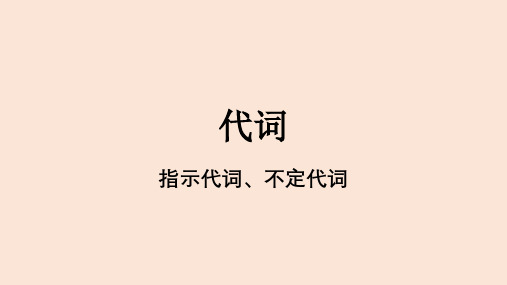
不定代词all,every和each
every用于三者或三者以上的疼或事物,是“每一个”的意思,只能作定语,强调 整体概念。 Every player is present. They helped us in every way. Evey child enjoys Christmas.
each是“每一个”的意思。each用于两者或两者以上的人或事物,着重个别概念。 Two men came into the room. Each carried an umbrella. Each book on this desk is worth reading.
5.不定代词
不定代词:不指明代替任何特定名词或形容词的代词 不定代词大都可以代替名词和形容词。多数可以作主语、宾语、表语或定语。
英语中常见的不定代词有: some; any; few; little; every; each; all; both; much; many; neither; either等
活学活用
1. These keys are mine. ___________ are yours. 2.---What's _____________? ---It's an egg.
---What's _____________ over there? ---It's an orange. 3. ---Look at _____________ pencils. Are they Lucy's? ---No, those are hers. _____________ are mine. 4. Hi, Mum, _____________ is my friend, Lucy. 5. ---What is ? --- is an apple. 6. ---Are your friends? ---Yes, are.
中考人教版英语:专题-语法填空(含答案) (3)
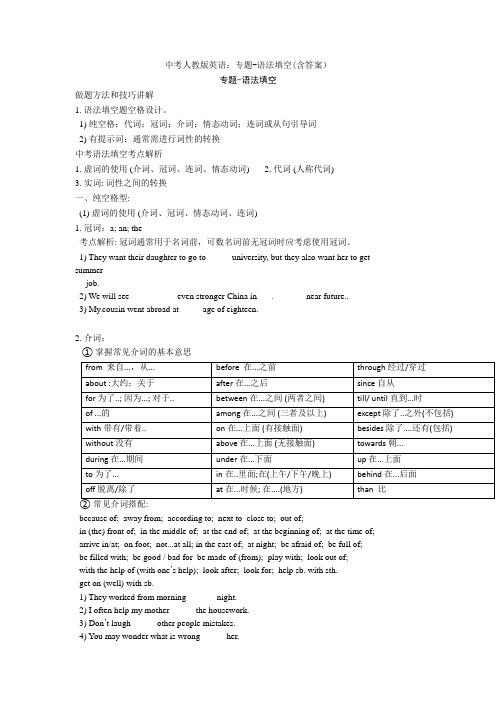
中考人教版英语:专题-语法填空(含答案)专题-语法填空做题方法和技巧讲解1. 语法填空题空格设计。
1) 纯空格:代词;冠词;介词;情态动词;连词或从句引导词2) 有提示词:通常需进行词性的转换中考语法填空考点解析1. 虚词的使用 (介词、冠词、连词、情态动词)2. 代词 (人称代词)3. 实词: 词性之间的转换一、纯空格型:(1) 虚词的使用 (介词、冠词、情态动词、连词)1. 冠词:a; an; the考点解析: 冠词通常用于名词前,可数名词前无冠词时应考虑使用冠词。
1) They want their daughter to go to _____ university, but they also want her to get ______summerjob.2) We will see __________ even stronger China in __________ near future..3) My cousin went abroad at_____ age of eighteen.2. 介词:①掌握常见介词的基本意思from 来自...,从...before 在...之前through 经过/穿过about :大约;关于after 在...之后since 自从for 为了..; 因为...; 对于..between在...之间 (两者之间)till/ until 直到...时of ...的among 在...之间 (三者及以上)except 除了..之外(不包括) with 带有/带着..on 在...上面 (有接触面)besides 除了....还有(包括) without 没有above 在...上面 (无接触面)towards 朝...during 在...期间under 在...下面up 在...上面to 为了...in在..里面;在(上午/下午/晚上)behind 在...后面off 脱离/除了at 在...时候; 在....(地方)than 比because of; away from; according to; next to close to; out of;in (the) front of; in the middle of; at the end of; at the beginning of; at the time of;arrive in/at; on foot; not...at all; in the east of; at night; be afraid of; be full of;be filled with; be good / bad for be made of (from); play with; look out of;with the help of (with one’s help); look after; look for; help sb. with sth.get on (well) with sb.1) They worked from morning ______ night.2) I often help my mother _____ the housework.3) Don’t laugh _____ other people mistakes.4) You may wonder what is wrong _____ her.3. 情态动词: 用于动词原形前should 应该 can / could 能;会; 可能 must 必须 may/might 可能 will /would 将要1). Harry’s been driving all day----- he be tired.2) --Pauline has lost her phone. –No. It’s in her bag. I _________ hear it.3) –Will the new iphone cost a lot? --I ______ think so. Apple’s products are usually expensive.4) If you _____ smoke,please go outside.5) I’m feeling much better now so you ______ call the doctor.参考答案: must can needn’t must needn’t4. 连词:考点解析: 两个句子放在一起,且没有连词连接两个句子,一定要填连词连接两个句子。
年中考英语语法非谓语专题3 现在分词和过去分词 课件

5.It was so cold that they kept the fire _b_u__r_n__in__g__ (burn) all night. 6. I always get my bike w___a_s_h__e_d__(wash). 7. They try their best to get us _i_n__t_e_r_e__s_t_e_d__ (interest) in this idea. 8.When I entered the theatre, I saw him _s_i_t_t_i_n__g_ in the first row.(sit)
二、分词的特点
过去分词表被动或完成
1. The boy named Bob is my brother. 2. He drank some boiled water quickly. 3. The USA is a developed country. 4. Fired food is not healthy.
C. followed
D. having followed.
3.With winter __D___ on, it's time to buy
warm clothes.
A. came B. comes C. come D. coming 4.The___B____price will save you one dollar
三. 现在/过去分词的功能
现在/过去分词具有形容词的特征,可 充当表语、定语、宾语补足语和状语。
1. I am excited. 2. The book written by Luxun is popular. 3. The result of the game made me disappointed. 4. Being ill, he didn't go to school.
专题3代词(原卷卷)---2023年中考英语考点详解专项训练
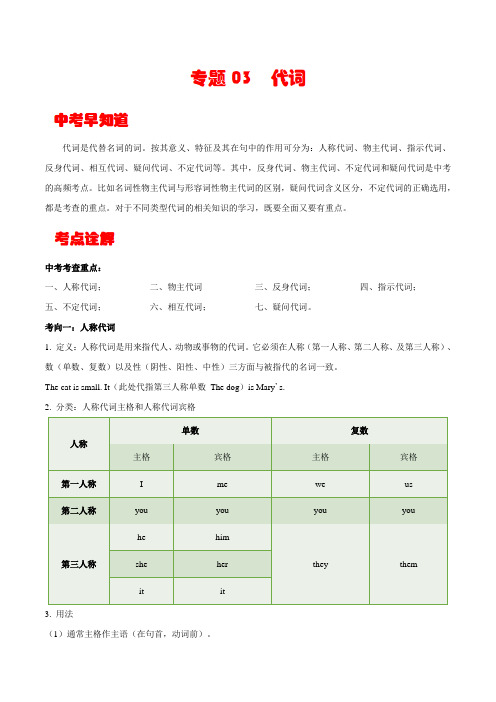
代词是代替名词的词。
按其意义、特征及其在句中的作用可分为:人称代词、物主代词、指示代词、反身代词、相互代词、疑问代词、不定代词等。
其中,反身代词、物主代词、不定代词和疑问代词是中考的高频考点。
比如名词性物主代词与形容词性物主代词的区别,疑问代词含义区分,不定代词的正确选用,都是考查的重点。
对于不同类型代词的相关知识的学习,既要全面又要有重点。
中考考查重点:一、人称代词;二、物主代词三、反身代词;四、指示代词;五、不定代词;六、相互代词;七、疑问代词。
考向一:人称代词1. 定义:人称代词是用来指代人、动物或事物的代词。
它必须在人称(第一人称、第二人称、及第三人称)、数(单数、复数)以及性(阴性、阳性、中性)三方面与被指代的名词一致。
The cat is small. It(此处代指第三人称单数The dog)is Mary’ s.2. 分类:人称代词主格和人称代词宾格人称单数复数主格宾格主格宾格第一人称I me we us第二人称you you you you第三人称he himthey them she herit it3. 用法(1)通常主格作主语(在句首,动词前)。
► He likes swimming. 他喜欢游泳。
(2)宾格作宾语(在动词或介词后)或作表语(在be动词后)。
► Can you understand me? 你能理解我吗?(作宾语)►—Who is knocking at the door? 谁在敲门?—It’s me. 是我。
(作表语)(3)人称代词在than之后与其他人或事物进行比较时,用主格和宾格都可以。
► Sam is much taller than I/me. 山姆比我高得多。
(4)单独使用的人称代词通常用宾格,即使它代表主语时也是如此。
►—I like travelling. 我喜欢旅游。
—Me too. 我也喜欢。
(5)人称代词并列时的排列顺序。
①人称代词单数并列作主语时,其顺序为:第二人称→第三人称→第一人称,即you, he/she/it and I(若是承担错误责任,第一人称应当先)。
中考英语语法突破【专题3】冠词知识点复习总结ppt课件(28页)
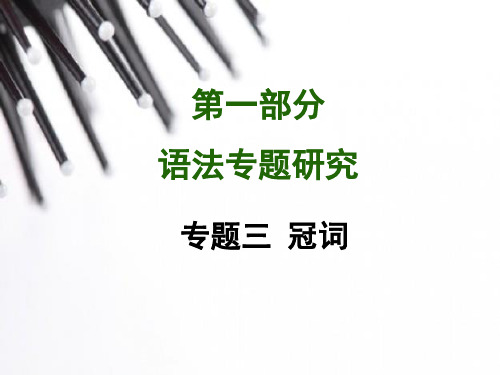
—Yes, it was really good. I think ____
boy in white was the best actor. A. a B. an C. the D. /
【解析】考查定冠词的用法。句意为“我非常 喜欢那场表演。”“是的,它真的不错。我认 为那个穿白衣服的男孩是最优秀的演员。”a表 泛指,用在辅音音素开头的单词前;an表泛指, 用在元音音素开头的单词前;the表特指;零冠 词放在诸如球类、三餐等名词前。此语境中表
中是 _____ 个诚实的人。 a表泛指,用在辅音音素开
头的单词前; an表泛指,用在元音音素开头的单词 球类等名词前。此处表泛指,又因 honest 为元音音 素开头的单词,其前冠词应用an。故选B。
前;the表特指;零冠词有特殊的用法,如用于三餐、
3. —I enjoyed the performance very much.
特指,故选C。
4. Mary was born in 1998 and she began to play _____ guitar at the age of seven. A. a B. 不 填 C. the D. an
【解析】 考查定冠词的用法。句意为:玛丽出生于 1998年,她七岁时开始弹吉他。a表泛指,用在辅音 音素开头的单词前; an 表泛指,用在元音音素开头
中
(2)通常不定冠词a用在以辅音音素开
头的单数可数名词前;an用在以元音音素开头
的单数可数名词前。判断一个单词是以元音 音素开头还是以辅音音素开头,要根据其读 音,而不是根据其字母。中考中常见的以元 音字母开头的单词有:
Aa
an apple/an artist/an aunt/an
初中英语语法专项3代词
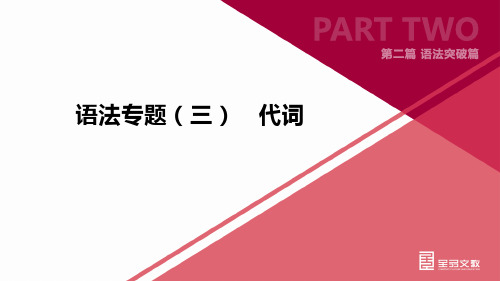
考点五 不定代词
1.定义 不指明代替任何特定名词或形容词的代词叫作不定代词。不定代词大多可以代替名词和形容 词。多数不定代词可以作主语、宾语、表语或定语。常见的不定代词有some, any, no, none, one, all, every, each, other, another, either, neither, both, many, much, (a) few, (a) little, a lot of, lots of以及some-, any-, no-, every-与-thing, -body或-one 构成的复合不定代词。
(3)(the) other, (the) others与another ①other泛指“另外的”,不能单独使用,后接名词。 ②others相当于“other+可数名词复数”,泛指别的人或物。 ③the other(+可数名词单数)指“两者中的另一个”,常用于“one…, and the other…”结构。 ④the others相当于“the other+可数名词复数”,表示“其余所有的人或物”。 ⑤another 泛指“三者或三者以上的人或物中的另一个”。 Do you have any other ideas? 你有别的想法吗? I have two brothers. One is a doctor, andthe other is a teacher. 我有两个兄弟。一个是医生,另一个是教师。 He is always ready to help others . 他总是乐意帮助别人。 Five of them are in the classroom.What abouthte others ? 他们中有五个人在教室里。其余的人呢? Don’t lose heart.Haveanother try. 别灰心,再试一次。
2024年贵州人教版英语中考第二部分---语法专题突破3+形容词和副词

2024人教版中考语法专题突破专题三形容词和副词形容词和副词思维导图考点1:形容词1.形容词的用法功能位置示例修饰名词和enough时,一般放在其前面She is a happy girl.她是一个快乐的女孩。
作定语修饰复合不定代词时,必须后置I have something important to tell you.我有很重要的事情告诉你。
作表语放在系动词后面作表语。
常见的系动词有:be,look,sound,smell,taste,feel,seem,get,turn,become等The soup smells delicious.这汤闻起来真鲜美。
★常见的只能作表语的形容词:alone,afraid,asleep,awake,alive,well,ill等作宾语补足语放在宾语之后,对其补充说明,常与make,find,keep等动词连用Keep the classroom clean and tidy,please.请保持教室干净整洁。
【知识拓展】1.某些形容词放在定冠词之后,表示一类人,作主语时谓语动词用复数。
常见的这类形容词有:good,bad,rich,poor,young,old,deaf,blind,living,dead等。
如:The old are happy in the park because they have a lot to do.老人们在公园很开心,因为他们有很多事可做。
2.多个形容词作前置定语修饰名词时的顺序口诀:限定描绘大长高,形状年龄和新老;颜色国籍跟材料,作用类别往后靠。
如:a nice large square old brown wooden table一张又大又漂亮的古老的棕色方木桌2.形容词相关的构词法1)常见的形容词前缀构成方法意义示例un-/in-/im-/dis-表示否定lucky→unlucky;direct→indirect;honest→dishonest a-形容词,表示处于某种状态sleep→asleep;wake→awake2)常见的形容词后缀类别构成方法意义示例表示天气的名词-y 充满……的;多……的cloud→cloudy;sun→sunny表示方位的名词-ern 朝……方向的west→western;east→eastern表示身份/时间的名词-ly ……般的;每……的friend→friendly;month→monthly表示物质的名词-en ……材质的wood→wooden;gold→golden表示大洲与国家的名词-n ……(人)的Asia→Asian;America→American表示人或物性质的动词-ed/-ing感到……的;令人……的relax→relaxed;surprise→surprising表示抽象意义的名词/动词-y;-al;-ful/-less;-able……的;无……的luck→lucky;success→successful;hope→hopeless考点2:副词1.副词的分类类别用法示例时间副词在句子中作时间状语now;today;then地点副词一般放在句末here;inside;somewhere方式副词大多由“形容词+ly”构成,放在不及物动词之后或放在句末carefully;successfully;wildly程度副词一般放在被修饰的形容词或副词之前much;too;quite频度副词一般放在行为动词之前,助动词、情态动词和be动词之后never;seldom;often疑问副词引导特殊疑问句when;how;why连接副词引导宾语从句或接动词不定式when;why;where关系副词引导定语从句where;when;why 【知识拓展】1.Why was Alice late?爱丽丝为什么迟到了?(why作疑问副词)2.I don’t know why Alice was late for school.我不知道爱丽丝为什么上学迟到了。
2020年中考英语语法复习3《代词》
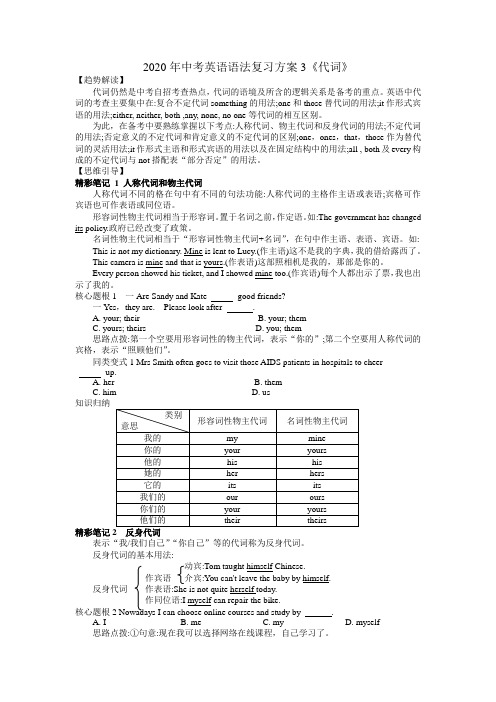
2020年中考英语语法复习方案3《代词》【趋势解读】代词仍然是中考自招考查热点,代词的语境及所含的逻辑关系是备考的重点。
英语中代词的考查主要集中在:复合不定代词something的用法;one和those替代词的用法;it作形式宾语的用法;either, neither, both ,any, none, no one等代词的相互区别。
为此,在备考中要熟练掌握以下考点:人称代词、物主代词和反身代词的用法;不定代词的用法;否定意义的不定代词和肯定意义的不定代词的区别;one,ones,that,those作为替代词的灵活用法;it作形式主语和形式宾语的用法以及在固定结构中的用法;all , both及every构成的不定代词与not搭配表“部分否定”的用法。
【思维引导】精彩笔记1 人称代词和物主代词人称代词不同的格在句中有不同的句法功能:人称代词的主格作主语或表语;宾格可作宾语也可作表语或同位语。
形容词性物主代词相当于形容词。
置于名词之前,作定语。
如:The government has changed its policy.政府已经改变了政策。
名词性物主代词相当于“形容词性物主代词+名词”,在句中作主语、表语、宾语。
如: This is not my dictionary. Mine is lent to Lucy.(作主语)这不是我的字典,我的借给露西了。
This camera is mine and that is yours.(作表语)这部照相机是我的,那部是你的。
Every person showed his ticket, and I showed mine too.(作宾语)每个人都出示了票,我也出示了我的。
核心题根1 一Are Sandy and Kate good friends?一Yes,they are. Please look after .A. your; theirB. your; themC. yours; theirsD. you; them思路点拨:第一个空要用形容词性的物主代词,表示“你的”;第二个空要用人称代词的宾格,表示“照顾他们”。
- 1、下载文档前请自行甄别文档内容的完整性,平台不提供额外的编辑、内容补充、找答案等附加服务。
- 2、"仅部分预览"的文档,不可在线预览部分如存在完整性等问题,可反馈申请退款(可完整预览的文档不适用该条件!)。
- 3、如文档侵犯您的权益,请联系客服反馈,我们会尽快为您处理(人工客服工作时间:9:00-18:30)。
中考英语语法专题详解三介词、连词一. 介词1. 介词概述:介词表示它与后面的名词或代词与其他句子成分的关系。
介词是虚词,不能单独做句子成分。
介词在英语中用法很活,也无一定规律可循。
在初中范围内还应学一个记住一个,特别是那些和动词的特殊搭配。
2. 常用介词的意义和用法。
⑴时间或地点介词in、on、at的用法区别:表示时间时, in表示在一段时间里(在将来时句子中则表示在一段时间之后), on表示在具体的某一天或者某天的上下午等, at表示在某个时刻或者瞬间;表示地点时, in表示在某个范围之内, on表示在某个平面上或与一个面相接触,at则表示在某个具体的场所或地点。
如:He was born on the night of May 10th.I usually get up at 7:00 in the morning.His glasses are on the desk.My brother is at the bus stop.⑵after与in表示时间的用法区别:“after+(具体时刻/从句)”表示“在…时刻之后”常用于一般过去时态;“in+(一段时间)”表示“在(多久)之后”,常用于将来时态。
如:He said that he would come back after 6:00.My father is coming back from Astralia in about a month.⑶since与for表示时间的用法区别:“since+(具体时刻/that-从句)”表示“自从…起一直到现在”,“for +(一段时间)”表示“持续一段时间”,都常用于完成时态;如:My father has worked in this factory since 1970.My father has worked in this factory for over 30 years.⑷by、in与with表示方式的用法区别:都可以表示“工具、手段”,但是by主要表示“乘坐”某个交通工具或“以……方式”,在被动句中可以表示动作的执行者;in表示“使用”某种语言/文字,with表示“使用”某个具体的工具、手段。
如:We write with our hands and walk with our feet.Please speak in English.Let’s go to the zoo by bus.It was invented by Adison.⑸about与on的用法区别:都可以表示“有关…”,但是about的意义比较广,而on 主要表示“有关…(专题/课程)”。
如:Tom is going to give a speech on the history of China.They are talking about the English test.⑹through与across、over的用法区别:through指“穿过…(门洞/人群/树林)”; across和over可以指“跨越…(街道/河流)”,可互换,但是表示“翻过…”时只能用over. 如:Just then a kangaroo (鼠)ran across the road.(就在那时一只袋鼠跑过路面)There is a bridge across/over the river.(河上有座桥)They climbed over the mountain and arrived there (他们翻过大山到达了那里)/ The visitors went through a big gate into another park.(参观者们穿过一个大门来到另一个公园)(7)as与like的区别:两个词都表示“像……”,但是as译为“作为……”,表示的是职业、职务、作用等事实,而like译为“像……一样”,表示外表,不是事实。
如:Let me speak to you as a teacher.(我以老师的身份和你讲话。
)Let me speak to you like a teacher.(让我像一位老师一样和你讲话)(8)in front of 与in the front of:in front of“在…的前面”, 与in the front of“在…的前部”。
如:A group of people was standing in front of the hall.In the front of the hall stood a group of people.(12)except与besides的区别:except“除了”,表示排除掉某人物,即不包含;而besides “除了”则表示包含,即“不仅……又……”。
如:Everyone went to the park except Tom.(除了Tom,大家都去了公园)(Tom没有去公园)/Besides maths he also studied many other subjects.(除了数学之外,他还学其他许多功课)(“数学”也是他学的功课之一)连词1.连词概述:连词是一种虚词,用于连接单词,短语或句子,但不单独做句子成分。
按照连词的性质,可将连词分为并列连词和从属连词。
并列连词如:and,but,or,for等,它们即可连接单词,短语,又可连接句子。
从属连词如:when,before ,because等,它们主要引导名词性从句。
2.常见连词的用法:1)并列连词的用法:并列连词有:and, but, or, nor, so, for yet, however, as well as, both...and, not only...but also, either...or, neither...nor, still,And:连接单词短语句子。
如:Tom and I study in the same school.But, or :I have a pen but no pencil. / Would you like coffee or tea?Nothing but除了,只有:I did nothing but watch it.Or表示否则:如:Hurry up or you will miss the train.for 表示后面的句子是原因。
如:He is good at piano for he practices harder than others.Not only…but also 不仅…而且。
可并列主、谓、宾、表及句子。
主语并列时,谓语要就近一致。
如: Not only he but also I am a nurse.As well as 以及,同样。
并列单词、短语、句子。
并列主语时,动词要随前面的主语变化 .如:He works as well as he canEither…or 既…又…,或…或…,并列主、谓、宾、表及状语,如:Either come in or go out.Neither…nor 既不…也不,并列主、谓、宾、表、状语,并列主语时,谓语就近一致。
如:Neither you nor he is lazy.Both…and 和,既…也,并列主、谓、宾及表语。
I can speak both English and French.nor 也不,引导句子要倒装。
如:He can not play the piano, nor can I.so 因此,所以,不和because连用。
如:You like swimming, so do I.1) 从属连词的用法:从属连词有:after, when, before, as, while, since, until, till, if, unless, because, than, that, whether, so thatafter 表示“时间”,在…之后。
如:After I finished the school, I became a worker in the factory.Although/though 表示让步,“尽管”。
如:Although she is young, she knows a lot.as 表示时间,“当…时”,方式“象…”,原因,“由于、因为”让步,“尽管、虽然”。
如:As it was rainy, we couldn’t go out now.As if/as though 表方式,“似乎、好像”。
如:He told us such a story as though he had been there before.As long as/so long as 表条件,“只要”。
如:As long as I am here, I’ll go to help you.As soon as 表时间,“一…就…”。
如:I will call you as soon as I come back.because 表原因,“因为”。
如:I have to practice more because I am not good at English.before 表时间,“在…之前’’。
如:You should think more before you do it.Even if/ even though 表让步,“即使”。
如:You should try again even if you failed.Hardly…when 表时间,“(刚)一…就”。
如:Hardly I entered the gate when the bell rang.if “假如”,引导条件状语从句。
如:We will stay at home if the rain doesn’t stop.“是否”,引导宾语从句。
如; I don’t know if he goes shopping.In order that 表目的,“为了,以便”。
如:We study hard in order that we can pass the exam.No matter +疑问词表让步,“无论,不管”。
如:No matter what you do, you should try your best.No sooner…than 表时间,“刚一…就…”。
如:No sooner had I come home than it began to rain.once 表时间,“一旦…”。
如:Once you read this book, you’ll never forget it.since 表时间,“自从…以来”.如:He has been in this city since he left school.表原因,“既然,由于”。
